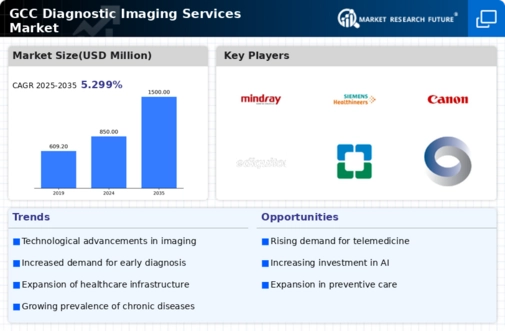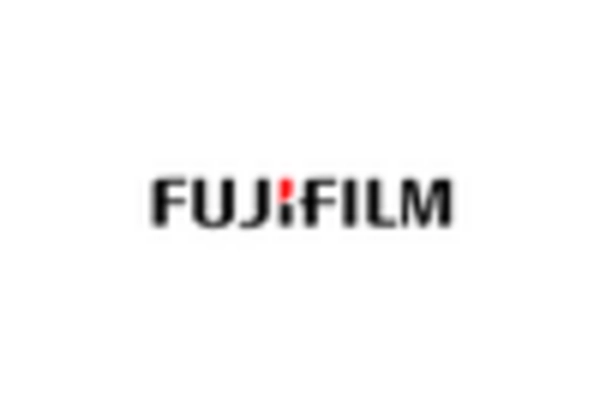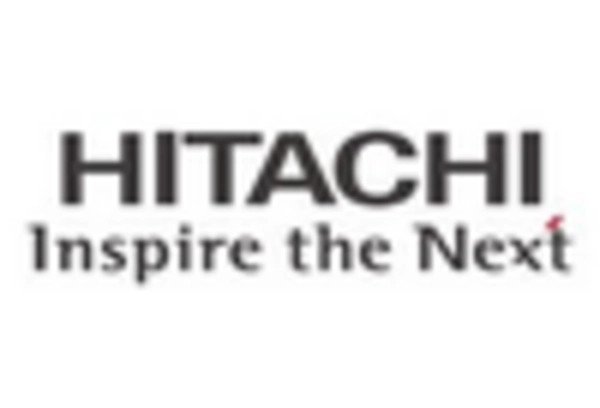Growing Aging Population
The demographic shift towards an aging population in the GCC is significantly influencing the diagnostic imaging-services market. As life expectancy increases, the elderly population is expected to rise, leading to a higher demand for medical services, including diagnostic imaging. Older adults are more susceptible to various health issues, necessitating regular screenings and diagnostic evaluations. Reports indicate that by 2030, the proportion of individuals aged 60 and above in the GCC is projected to increase by approximately 30%. This demographic trend is likely to propel the diagnostic imaging-services market, as healthcare providers invest in advanced imaging technologies to cater to the specific needs of the aging population.
Focus on Patient-Centric Care
The shift towards patient-centric care in the GCC is reshaping the diagnostic imaging-services market. Healthcare providers are increasingly prioritizing patient experience and outcomes, leading to the development of tailored diagnostic services. This approach emphasizes the importance of accurate and timely diagnoses, which are essential for effective treatment plans. As patients become more informed and involved in their healthcare decisions, the demand for high-quality imaging services is likely to rise. Additionally, healthcare facilities are investing in training and development programs for radiologists and technicians to ensure that they are equipped to meet the evolving needs of patients, further driving growth in the diagnostic imaging-services market.
Increased Healthcare Expenditure
The rising healthcare expenditure in the GCC is a crucial driver for the diagnostic imaging-services market. Governments in the region are allocating substantial budgets to enhance healthcare infrastructure and services, which includes investments in diagnostic imaging technologies. Recent data indicates that healthcare spending in the GCC is projected to grow at a CAGR of 7% over the next five years. This increase in funding is likely to lead to the acquisition of advanced imaging equipment and the establishment of specialized diagnostic centers, thereby expanding the diagnostic imaging-services market. Enhanced funding also supports research and development initiatives, fostering innovation in imaging technologies.
Rising Prevalence of Chronic Diseases
The increasing incidence of chronic diseases in the GCC region is a pivotal driver for the diagnostic imaging-services market. Conditions such as diabetes, cardiovascular diseases, and cancer are becoming more prevalent, necessitating advanced diagnostic tools for early detection and management. According to recent health statistics, the prevalence of diabetes in the GCC has reached alarming levels, with estimates suggesting that over 25% of the adult population is affected. This surge in chronic conditions drives the demand for imaging services, as healthcare providers seek to implement effective diagnostic strategies. Consequently, the diagnostic imaging-services market is likely to experience substantial growth as healthcare systems adapt to the rising need for comprehensive diagnostic solutions.
Technological Integration in Healthcare
The integration of advanced technologies in healthcare is transforming the diagnostic imaging-services market. Innovations such as artificial intelligence (AI), machine learning, and telemedicine are enhancing the accuracy and efficiency of diagnostic imaging. AI algorithms are being utilized to analyze imaging data, improving diagnostic precision and reducing the time required for interpretation. Furthermore, the adoption of telemedicine is facilitating remote consultations, allowing patients to access imaging services without geographical constraints. As healthcare facilities in the GCC increasingly adopt these technologies, the diagnostic imaging-services market is expected to expand, driven by the demand for more efficient and accessible diagnostic solutions.

















Leave a Comment